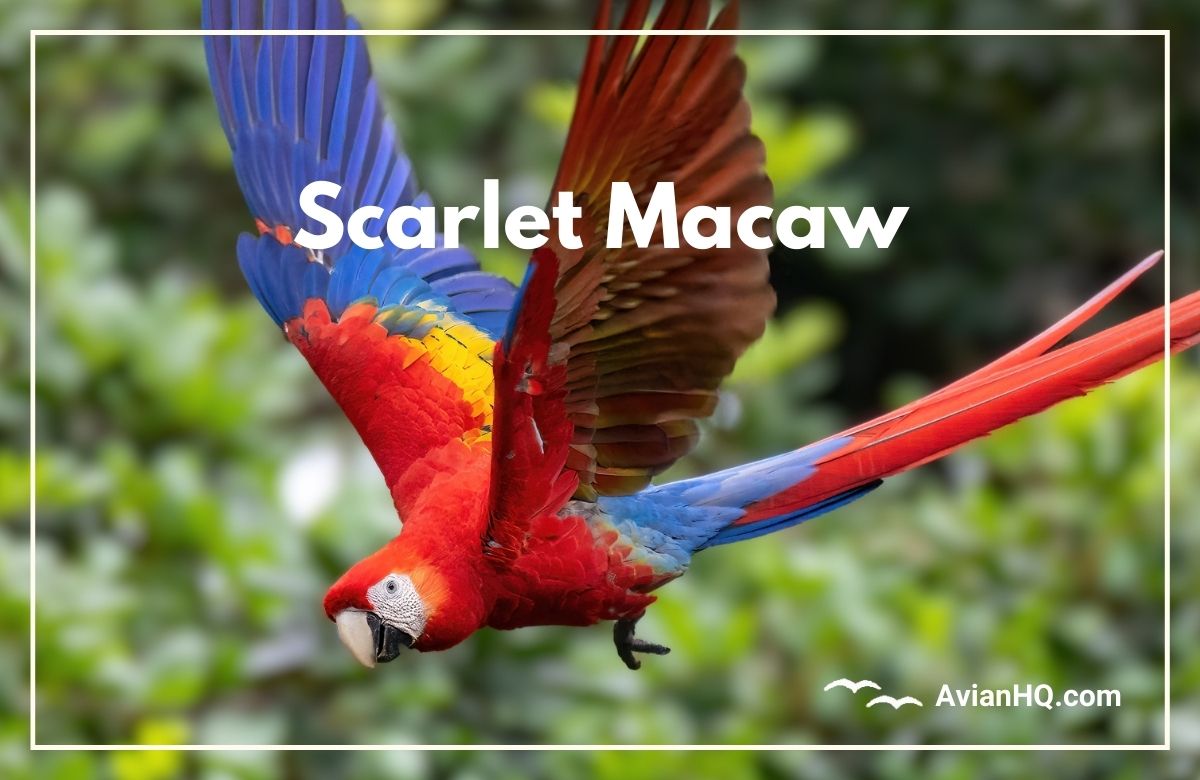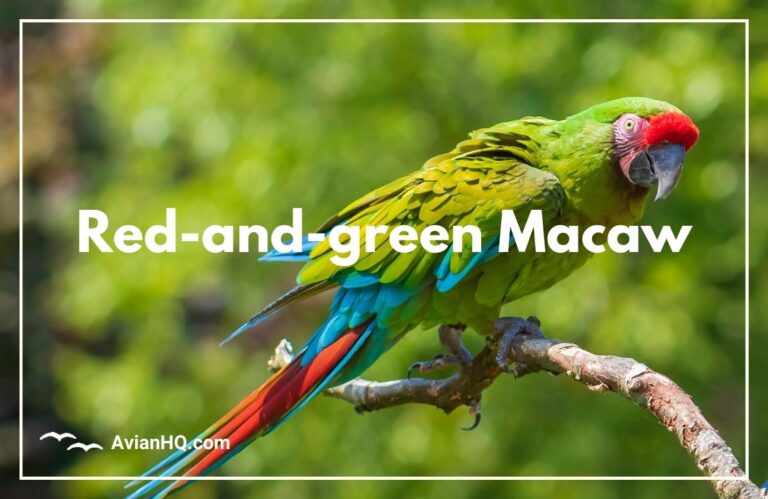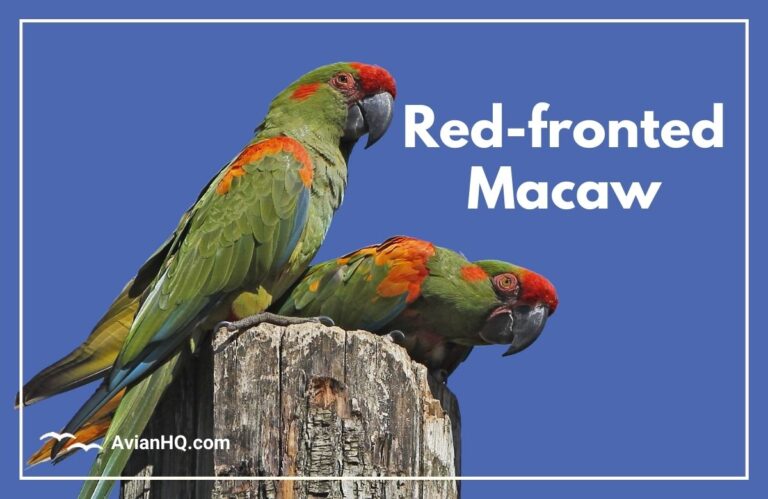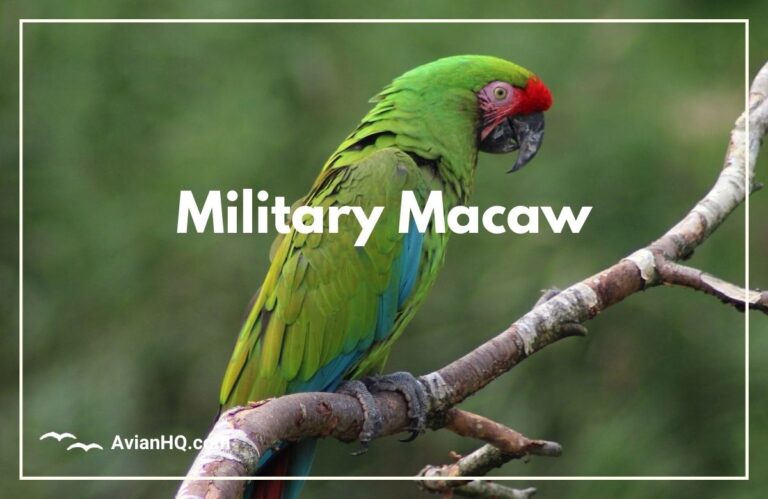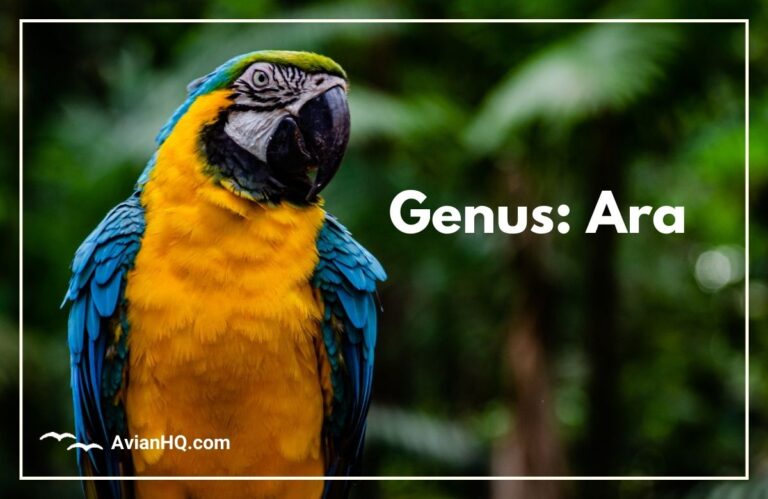Scarlet Macaw (Ara macao)
The striking scarlet macaw is known for its vibrant red, yellow and blue plumage. As one of the largest and most colorful parrots in its range through Central and South America, this species makes an imposing and unforgettable sight.
If you’re curious to learn more about these magnificent birds, you’ve come to the right place. This in-depth guide will provide key facts and details on scarlet macaw biology, behavior, conservation status and more. We’ll cover everything from their preferred foods and typical flock sizes to breeding habits and current threats these parrots face in the wild.
Basic Details on the Scarlet Macaw
Before delving further into scarlet macaw natural history, let’s review some quick basics:
- Length: 81-85 centimeters or 32-33 inches
- Wingspan: 41 inches or 104 centimeters
- Weight: 2-2.5 pounds or 1-1.1 kilograms
The scarlet macaw has a large, curved black beak with a pale upper mandible, surrounded by a vibrant red face with lines of small white feathers. Bright yellow eyes peer out from the often-flushed bare skin around them.
Their most obvious features are the bold red, blue and yellow patches formed across their body plumage. We’ll explore more plumage specifics in the next section.
So in a nutshell, these are large, strongly-colored parrots measuring over three feet long. Their visually striking appearance plays a role in many of their key behaviors. Read on to understand more about how scarlet macaws interact with their environments.
History and Taxonomy
The vibrant beauty of the scarlet macaw caught the attention of scientists relatively early on. In 1758, Swedish taxonomist Carl Linnaeus gave the first scientific name to this species, classifying it as Psittacus macao in the 10th edition of his pivotal work Systema Naturae.
Over 40 years later in 1799, the French naturalist Bernard Germain de Lacépède moved this species to its current genus of Ara. Two subspecies are now recognized:
- Ara macao macao: The nominate South American subspecies described by Linnaeus. Their wing coverts feature green tips.
- Ara macao cyanopterus: The larger North Central American subspecies, named by German ornithologist Dietrich von Wiedenfeld in 1995. Their wing covert tips are blue instead of green.
The scarlet macaw’s genetic relationships to other macaw species were further illuminated in 2013. A Texas A&M team led by Dr. Christopher M. Seabury and Dr. Ian Tizard fully sequenced the scarlet macaw genome for the first time. This allows for better understanding of the evolution and conservation needs of scarlet macaws in the wild.
So in terms of taxonomic history, the vibrant red macaws scientists know as Ara macao today were first described over 250 years ago and named as a distinct species. Their genetics and subspecies delineations have been clarified through more recent study.
Physical Appearance
The scarlet macaw’s vibrant plumage and striking facial patterns are integral parts of its appearance and recognition. As we review key physical traits, we’ll also touch on how certain features aid their behavior and habitat use.
Plumage and Markings
True to their common name, scarlet macaws sport predominantly scarlet red feathers covering their body, wings and long graduated tails. This includes their crown, nape, throat, breast and belly areas.
Rich blue hue paints the rump, upper tail coverts and flight feather tips. Vibrant yellow feathers stand out prominently along the greater upper wing covert area.
The tail averages 13-16 inches (33-41 centimeters) on adult birds – an impressive portion of their total 32-33 inch (81-85 centimeter) body length. Juveniles start out with noticeably shorter tail feathers.
Facial Skin and Bill
Bare white facial skin, often flushed pink or red, encircles each eye and covers the area between the eye-ring and upper bill. The macaws’ heavy black lower bill and pale yellow eyes stand out sharply against this skin.
Faint red feather lines border the bare patches in some individuals. The facial skin assists thermoregulation in hot environments and may help scarlet macaws detect air movement around fruits and seeds.
Subspecies Variations
The Central American subspecies A. m. cyanopterus averages slightly larger in body size than its South American counterpart A. m. macao. Its wing covert tips tend more towards blue than green.
Juveniles of both subspecies initially show grey eye coloration before attaining their mature yellow irises. Their facial patterns remain similar. Geographic variations in shade intensity can occur across different scarlet macaw populations.
Purpose of Visual Signaling
The scarlet macaw’s vivid red plumage announces its presence from afar. This helps attract mates and defend territory among tall rainforest trees. Their bright facial skin likely serves as a visual signal during communication.
We’ll later explore how pairs may coordinate behaviors through unique facial flushing cues. So in essence, the scarlet macaw’s beauty serves definite functional purposes beyond the aesthetic.
Habitat and Distribution
Scarlet macaws inhabit a broad swath of humid lowland rainforest and adjacent habitat types in the Neotropics. But their status and degree of dependence on rainforest ecosystems varies across their range, which stretches from Mexico down to Bolivia and Brazil.
Native Range Through Central and South America
The scarlet macaw’s expansive native range extends from southeastern Mexico through Central America into Peru, Ecuador, Colombia, Venezuela, Bolivia and Brazil in northern South America.
They reach their southern range limit in the Amazon Basin and southern Peru, Bolivia, and Brazil. Scarlet macaws reside primarily at lower elevations up to 3,300 feet (1,000 meters), sticking to humid tropical and subtropical rainforests. This includes evergreen, semi-deciduous, gallery, and mangrove forest ecosystems.
Stable Introduced Populations
Conservationists consider scarlet macaws native parrots, yet small introduced breeding populations persist outside their natural distribution. For instance, isolated groups thrive in wooded parks and urban areas of southern Florida and Puerto Rico. These likely stem from past caged bird releases. Introduced scarlet macaws rely more on artificial food here than wild fruits.
Local Variation in Elevation
While often dwelling below 1,600 feet (500 meters), scarlet macaws locally occupy Andean foothill forests up to 6,600 feet (2,000 meters). Their prime habitat generally lies at lower, warmer elevations with an abundance of palm trees. But cooler temperatures don’t deter them from venturing higher in countries like Peru and Costa Rica. There they exploit unique nesting resources.
So from lowland rainforests holding the highest numbers through locally higher haunts, the habitat use span of scarlet macaw offers notable flexibility while centering on hot, humid forests.
Diet and Feeding
Scarlet macaws utilize their large, powerful beaks to access a diverse range of foods across an extensive habitat range. Their diet varies seasonally with food availability but consistently centers on hard palm fruits and nuts.
Primary Components of the Diet
The scarlet macaw diet consists mainly of seeds, nuts, fruits, berries, and flowers from multiple rainforest trees and palms. Favored staples include:
- Large, tough palm nuts from Scheelea, Attalea, Acrocomia, and Bactris genera
- Fruits/arils from Terminalia, Spondias, Ficus, and Virola trees
- Seeds from mountain almond (Dipteryx panamensis) trees
- Flowers and nectar from Erythrina, Ochroma, and Pentaclethra species
Scarlet macaws supplement this largely vegetarian fare with occasional protein-rich insects, snails or nestling birds. Their powerful beaks capably crack hard seeds other birds can’t access.
Feeding Behavior Patterns
Scarlet macaws often feed in mated pairs or small familial flocks of up to 30 individuals. They regularly gather at river clay licks to obtain essential minerals and neutralize plant toxins.
Pairs may nest in one tree and travel up to 12 miles to feed together at another. Some populations concentrate feeding efforts on abundant seasonal fruits like mangoes. Throughout the year, the scarlet macaw diet shifts based on food availability within their complex habitats.
So whether nestled inside frond palms or foraging far afield, scarlet macaws adeptly use their beaks to unlock a wealth of food resources. This facilitates their distribution across diverse forest ecosystems.
Breeding and Reproduction
Scarlet macaws form long-term pair bonds and engage in coordinated breeding behaviors using vocalizations and visual displays. Their reproduction cycle features nest site fidelity, clutch incubation duties, and extended parental care.
Pair Bonds and Courtship
Scarlet macaws are monogamous, mating with a single partner for life. Pairs engage in bonding behaviors year-round like preening, food sharing and flying together. Courtship displays involve loud vocalizations, spreading wings/tail, and exaggerated head bobs.
Unique bare skin flushing extends from scarlet macaw faces down their necks during breeding interactions. Partners likely interpret skin redness and eye pinning changes as visual cues.
Nest Sites and Egg Laying
From February to June, mated pairs nest in unlined tree cavities up to 200 feet (60 meters) high. Pairs often reuse nest sites across different years. The female typically lays 2-4 white eggs per clutch. Highly territorial adults fiercely defend their nest sites.
Incubation Period and Fledging
Incubation lasts 24-25 days before the altricial chicks hatch. Both parents brood and feed the rapidly growing chicks. Nestlings fledge at 12-15 weeks old, but continue receiving parental care until independence at 1-2 years old.
Reproductive Maturity
Young scarlet macaws become sexually mature and attempt breeding at 4-5 years old. Their long-term bonds and extended offspring rearing contributes to low annual reproductive rates for the species.
So scarlet macaw reproduction involves complex long-term partnerships, vocal/visual bonding behaviors, and extended parental effort culminating in just a few fledglings per year.
Behavior and Ecology
Scarlet macaws exhibit a mix of solitary and gregarious behaviors across their range. Their loud calls and mobility facilitate both feeding and breeding strategies. Complex interactions shape their ecology among rainforest ecosystems.
Social Patterns and Communication
Scarlet macaws may forage solo or in pairs, but aggregate in larger flocks at clay licks and nocturnal roosts. Loose foraging flocks average 15-20 birds but may amass up to 30-40 at abundant food sources. Social grooming reinforces bonds.
Raucous honks and screams carry long distances for contact and territorial displays. Scarlet macaws swagger expertly on branches while vocalizing. So while bonded pairs remain most crucial socially, they thrive on some group dynamics amid rainforest biodiversity.
Roosting and Foraging Movements
Communal roosts form each night in the upper canopy of emergent trees. Pairs and families depart daily to exploit feeding grounds up to 20 kilometers (12 miles) away. Their strong flight allows mixing across fragmented habitats.
Some populations feast extensively on seasonal fruits. Agile scarlet macaws forage acrobatically and suspend below branches while feeding. They dominate fruits other birds can’t open using specialized beak muscles and tongue structure.
Interactions with Other Species
Symbiotic relationships with mammals aid dispersal and germination of key macaw food plants like Shebelle palms. Smaller birds may nest in abandoned scarlet macaw cavities. At clay licks, dozens of parrot species congregate without conflict after scarlet macaws finish.
Yet scarlet macaws aggressively compete with other birds and monkeys over limited unopened fruit bunches and tree cavities. Their interactions help shape plant succession and biodiversity within sensitive rainforest ecosystems.
So ranging behavior, adaptations for mobility/harvesting food, and connections with other forest-dwellers underpin the scarlet macaw’s integral links to fragile Neotropical habitats.
Conservation Status
While still locally common in parts of their range, scarlet macaw populations face growing threats from habitat loss and illegal wildlife trafficking across Central and South America. Their situation varies greatly by country and region.
IUCN Red List Status
The International Union for Conservation of Nature (IUCN) Red List categorizes the scarlet macaw’s conservation status as Least Concern. Researchers estimate their total global population at 50,000-500,000 individuals. But some localized populations are endangered.
Population Trends Across Native Range
Scarlet macaw numbers remain stable across most of the Amazon Basin thanks to vast rainforest areas still intact. Their strongholds occur in remote regions of Peru, Bolivia and Brazil. Smaller Central American and Mexican populations are endangered primarily from habitat destruction and capture for the pet trade.
Major Threats
The primary threats starving scarlet macaw populations include:
- Widespread deforestation destroying native habitat
- Illegal poaching of chicks for profitable exotic pet trade
- Persecution as agricultural pests raiding crops
Agro-industrial palm oil and soybean operations are encroaching on crucial breeding areas in Peru and Brazil. Nest poaching also remains an issue.
Protection Efforts and Conservation
Key initiatives aimed at scarlet macaw conservation include:
- Habitat preservation partnerships in Costa Rica, Guatemala and Mexico
- Bolstering wild populations with captive-bred releases
- Community monitoring for deterring nest poachers
- Limiting capture and export through CITES regulations
Continued cooperation between governments, conservancies, researchers and land managers is vital for shielding critical strongholds and restoring fragile scarlet macaw populations decimated by human impacts.
So while still thriving across significant areas, concentrated conservation efforts like combating trafficking and fragmented habitat links are needed to secure long-term scarlet macaw survival.
Cultural Significance
The large, beautifully colored scarlet macaw holds special meaning for many indigenous cultures across their Latin American ranges. Symbolism of these red, blue and yellow birds appears widely in regional artwork, legends, and practices.
Prominence in Ancient Native Art
Brilliant specimens feature prominently on Maya murals, ceramics, and carved jade across ancient sites in southern Mexico, Guatemala, and Honduras. Scarlet macaw symbolism complements their importance in Maya religious belief and trade.
The southeastern Pueblo tribes and Paquimé culture in northwestern Mexico also depict scarlet macaws in connection with intricate ceremonies. Remains and cages for captive birds occur at archaeological sites.
Spiritual and Wildlife Significance
Many Central and South American cultures revere scarlet macaws through ceremonial use, releases, folklore, fables and dances portraying these imposing birds. They often represent powerful spirits, ancestors, the sun, fertility, or communication between worlds.
The Maya and eastern Bolivian Sirionó tribe hold the scarlet macaw as their sacred tribal emblem. These culturally vital birds remain legal to own by indigenous groups for spiritual practices in Mexico and Peru.
National Bird Status and Ecotourism Potential
Honduras designated the vivid scarlet macaw as their official national bird based on its prominence in folk culture and rainforest ecosystems. Many Latin countries also feature this species on postage stamps and currency.
As charismatic flagship species of Neotropical forests, scarlet macaws hold substantial potential for boosting conservation support and environmentally-conscious birding tourism across their ranges. From inspiring art and myth to national pride, the scarlet macaw’s cultural ties run deep through history and modern aspirations.
Conclusion
The scarlet macaw’s vibrant plumage and imposing stature capture imaginations, but also signify the integral links these birds share with threatened Neotropical habitats. Their persistence hinges on conservation amid the forests they influence.
As we’ve explored through this extensive overview, scarlet macaws play multifaceted ecological roles from dispersing and propagating rainforest plant species. Their beauty and behaviors also intertwine with human cultures past and present.
Despite localized population declines, robust numbers still course over sections of the Amazon and Central America’s great rainforests. Protecting sufficient habitat and food sources where they breed can help buffer scarlet macaws against further fragmentation.
Bolstering connectivity for small isolated groups also remains vital for maintaining genetic health and numbers to uphold scarlet macaws’ stature as iconic fixtures highlighting the grandeur of Latin America’s imperiled woodlands.
Through proactive habitat programs, poaching deterrents, and choosing tourism options aiding local communities, people from Mexico to Peru can aid scarlet macaw preservation throughout their cross-continental ranges.
The survival prospects remain promising for these beloved birds in many regions. But active conservation engagement is crucial for ensuring vital scarlet macaw populations continue brightening forest canopies for posterity.

